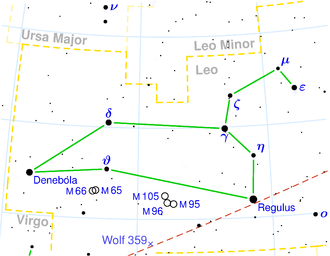NGC 3602
| Galaxy NGC 3602 |
|
|---|---|

|
|
| SDSS recording | |
| AladinLite | |
| Constellation | lion |
|
Position equinox : J2000.0 , epoch : J2000.0 |
|
| Right ascension | 11 h 15 m 48.3 s |
| declination | + 17 ° 24 ′ 58 ″ |
| Appearance | |
| Morphological type | SC / LINER |
| Brightness (visual) | 15.0 mag |
| Brightness (B-band) | 15.8 mag |
| Angular expansion | 0.8 'x 0.2' |
| Position angle | 48 ° |
| Surface brightness | 12.9 mag / arcmin² |
| Physical data | |
| Redshift | 0.020000 ± 0.000150 |
| Radial velocity | 5996 ± 45 km / s |
|
Stroke distance v rad / H 0 |
(265 ± 19) x 10 6 ly (81.2 ± 5.7) Mpc |
| history | |
| discovery | Albert Marth |
| Discovery date | March 4, 1865 |
| Catalog names | |
| NGC 3602 • PGC 34351 • CGCG 096-017 • MCG + 03-29-017 • 2MASX J11154832 + 1724579 • GALEX ASC J111548.43 + 172458.8 • NSA 111859 | |
NGC 3602 is a spiral galaxy with an active nucleus of the Hubble type Sb in the constellation Leo on the ecliptic . It is an estimated 265 million light years away from the Milky Way and about 65,000 light years in diameter.
The galaxies NGC 3592 , NGC 3598 , NGC 3605 , IC 2703 are located in the same area of the sky .
The object was discovered by Albert Marth on March 4, 1865 .
